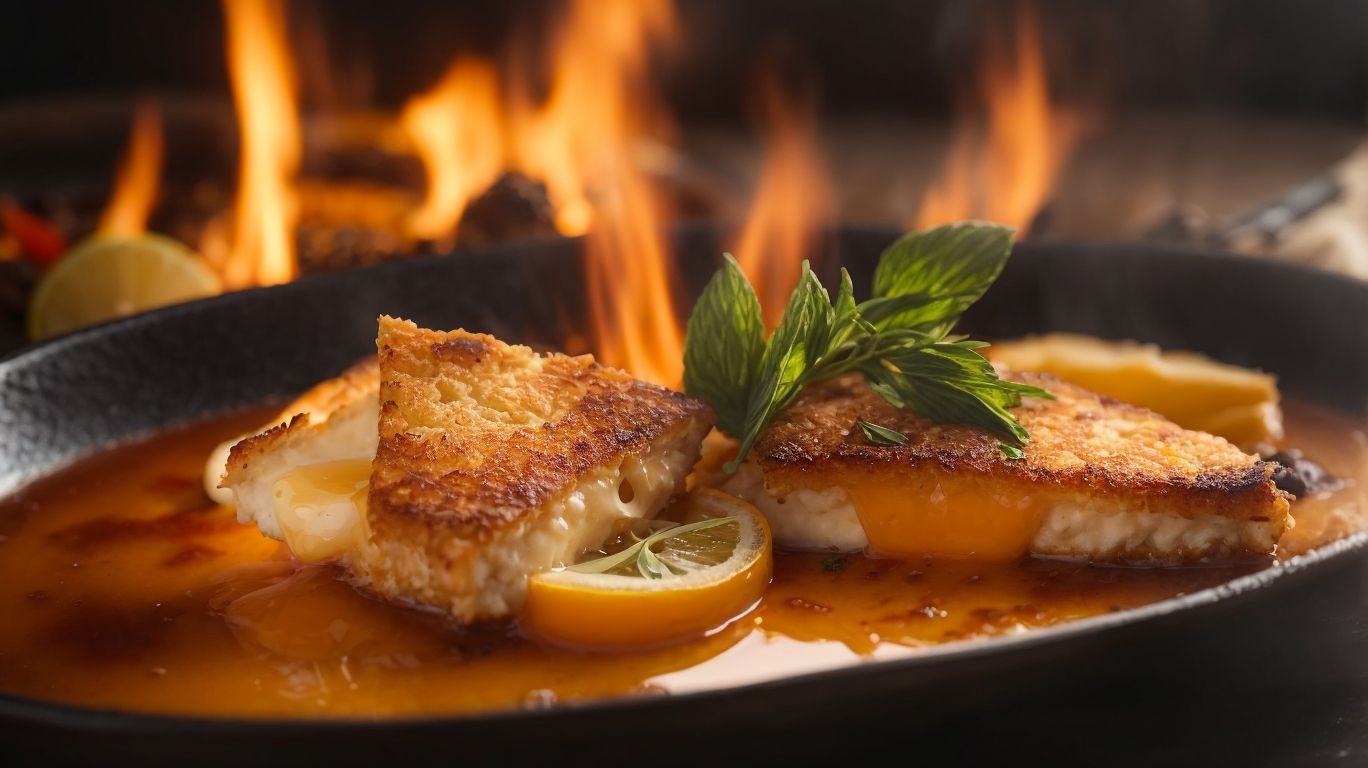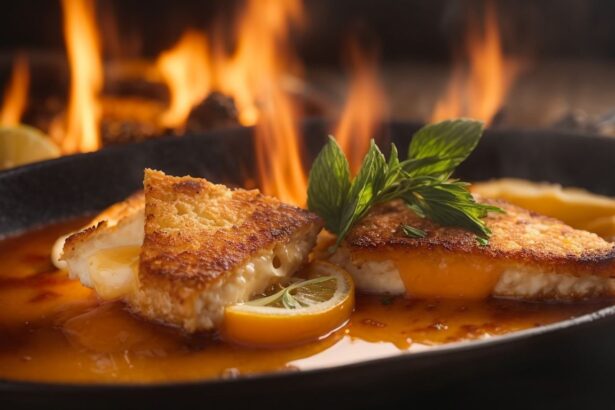
Saganaki, a beloved Greek dish, is known for its delicious combination of flavors and its unique presentation involving flames. This article will delve into the details of Saganaki, including its origins, cultural significance, the process of making it, what makes it perfect, serving suggestions, and variations.
What is Saganaki? Saganaki is a traditional Greek dish that typically consists of cheese, most commonly Kefalograviera or Kasseri, which is coated in flour and pan-fried until crispy and golden. The dish is often finished with a touch of lemon juice and can be served alone or as part of a meze platter.
Origins and Cultural Significance: Saganaki has a long history in Greek cuisine and is believed to have originated in Greece. It holds cultural significance as it showcases the country’s culinary traditions and is often included in celebratory meals or as an appetizer in Greek tavernas.
How to Make Saganaki? Making Saganaki requires a few simple steps. The dish consists of two main components: the cheese and the cooking method. The cheese is a crucial element, and choosing the right variety is essential. The process involves coating the cheese in flour and cooking it in a hot pan until it develops a crispy outer layer. The dish is then finished by squeezing lemon juice over the cheese.
What Makes Saganaki Perfect? The perfection of Saganaki lies in specific factors. Choosing the right cheese is vital, as it affects the texture and flavor of the dish. The technique of flambéing the Saganaki by adding alcohol and igniting it adds a dramatic touch while enhancing the taste. These elements contribute to the unique and delightful experience of enjoying Saganaki.
Serving and Enjoying Saganaki: Saganaki is typically served hot and can be enjoyed as an appetizer or part of a larger meal. It is often accompanied by various dips and condiments such as tzatziki or a squeeze of fresh lemon juice. Pairing it with the right wine can further elevate the dining experience.
Variations of Saganaki: While the classic version of Saganaki is made with cheese, there are variations that incorporate different flavors and ingredients. These variations offer a range of options to suit different taste preferences and dietary restrictions.
By exploring the origins, making process, key elements that make it perfect, serving suggestions, and variations, this article will provide an in-depth understanding of Saganaki, allowing readers to appreciate and indulge in this delicious Greek dish.
Key Takeaways:
- Saganaki: A delicious Greek flaming cheese dish that is a popular appetizer in Greek cuisine.
- Choosing the Right Cheese: The key to perfect Saganaki lies in selecting the appropriate cheese that melts well and has a savory flavor, such as Kefalotyri or Halloumi.
- Flaming the Saganaki: The theatrical flaming of the Saganaki not only adds visual appeal but also imparts a unique smoky flavor to the dish.
What is Saganaki?
Saganaki, the perfect Greek flaming cheese – let’s dive into what it truly is. Discover the rich origins and cultural significance that surround this beloved dish. Uncover its fascinating roots and understand why it has become a staple in Greek cuisine. Get ready to indulge in the delectable history and tradition that make Saganaki a truly remarkable culinary experience.
Origins and Cultural Significance
The origins and cultural significance of Saganaki can be traced back to Greece. Saganaki is a traditional Greek dish that holds a special place in Greek cuisine and culture. It is believed to have originated in the taverns of Greece, where it was first cooked and served. The word “saganaki” refers to the small frying pan used to prepare the dish.
This dish has become an iconic element of Greek cuisine and is often associated with celebration and joy. It is commonly served as an appetizer or meze and is enjoyed by both locals and visitors alike.
Story: In the Greek town of Thessaloniki, there is a small family-owned tavern that has been serving Saganaki for generations. The owner, Yannis, learned the art of making Saganaki from his grandfather, who taught him the importance of using high-quality cheese and flaming it to perfection. The tavern has become a gathering place for locals and tourists who come to experience the authentic taste of Saganaki and celebrate the rich culinary traditions of Greece.
How to Make Saganaki?
If you’re eager to learn the secrets of making the mouthwatering Greek delicacy, Saganaki, look no further. In this section, we’ll dive into the art of crafting this sizzling dish that will ignite your taste buds. From the essential ingredients to the intricate preparation and the cooking method, we’ll uncover the step-by-step process to create the perfect Saganaki. Get ready to embark on a culinary adventure that will transport you to the vibrant streets of Greece.
Ingredients
The ingredients for making Saganaki can vary depending on the specific recipe and variations. Here is a table summarizing some common ingredients used in Saganaki preparations:
| Ingredients | Typically, Saganaki is made using firm and salty cheeses such as Kefalograviera, Kasseri, or Halloumi. These cheeses have a high melting point that allows them to be fried or grilled without losing their shape. |
| Flour | Coating the cheese in flour before frying helps to create a crunchy and golden crust. |
| Olive oil | Olive oil is commonly used for frying the cheese and adds a rich flavor to the dish. |
| Lemon juice | Squeezing fresh lemon juice over the Saganaki just before serving adds a tangy and refreshing element to the dish. |
| Herbs and spices | Additional flavors can be added using herbs like oregano or thyme, as well as spices like black pepper or red pepper flakes. |
Preparation and Cooking Method
| Preparation and Cooking Method |
| 1. Heat a skillet or frying pan over medium heat. |
| 2. Add a drizzle of olive oil and let it heat up. |
| 3. Cut the cheese into thick slices or wedges. |
| 4. Dip each piece of cheese into flour, ensuring it gets coated evenly. |
| 5. Shake off any excess flour and place the cheese in the hot skillet. |
| 6. Cook each side for about 2-3 minutes, or until golden brown and crispy. |
| 7. Remove the saganaki from the pan and place it on a serving plate. |
| 8. Squeeze fresh lemon juice over the saganaki and garnish with fresh herbs or chili flakes (optional). |
The preparation and cooking method of saganaki is fairly simple. By following these steps, you can achieve a delicious crispy cheese dish that is popular in Greek cuisine. It is important to ensure that the cheese is coated in flour properly and cooked until golden brown for the best results. Saganaki is often served as an appetizer and pairs well with a variety of accompaniments and wine. Enjoy this flavorful dish and explore its variations with different flavors and ingredients.
What Makes Saganaki Perfect?
Saganaki, the perfect Greek flaming cheese. Let’s uncover what makes it so exceptional! Delve into the art of selecting the right cheese and discover the secrets behind the mesmerizing flaming process. Prepare to be amazed as we unravel the key ingredients to achieve the ultimate saganaki experience. Get ready to tantalize your taste buds and embrace the fiery delight that awaits you!
Choosing the Right Cheese
When it comes to choosing the right cheese for making the perfect Saganaki, it is essential to consider various options.
- Kefalotyri: As a traditional choice, this hard cheese offers a savory, salty flavor that is perfect for flaming Saganaki.
- Halloumi: Renowned for its squeaky texture, this cheese holds its shape well and brings a unique taste to the dish.
- Kasseri: With its slightly tangy flavor and melt-in-your-mouth texture, Kasseri cheese is an excellent option for Saganaki.
- Feta: While not the traditional choice, feta can still be a delicious alternative, providing its signature salty and tangy taste.
Feel free to experiment with different cheeses to discover your favorite flavor combination and savor the gooey, crispy goodness of Saganaki.
Flaming the Saganaki
Flaming the Saganaki is a crucial step in preparing this Greek dish. It adds a unique visual and flavor experience to the dish. Here is a table summarizing the process:
| Step | Description |
| 1 | Heat a pan or skillet with olive oil or butter. |
| 2 | Add the cheese, such as Kefalotyri or Halloumi, to the hot pan. |
| 3 | Wait for the cheese to get golden brown and crispy on one side. |
| 4 | Remove the pan from the heat and add a splash of alcohol, such as brandy or ouzo, over the cheese. |
| 5 | Carefully ignite the alcohol with a match or lighter, causing the flames to engulf the cheese briefly. |
| 6 | Allow the flames to subside before serving the flaming Saganaki. |
Serving and Enjoying Saganaki
Get ready to take your Saganaki experience to the next level as we dive into the art of serving and savoring this delectable Greek flaming cheese. Discover the exciting world of accompaniments and dips that perfectly complement the rich, gooey texture. And let’s not forget about the ultimate wine pairings that elevate the flavors to new heights. Get ready to indulge in a culinary adventure that will leave your taste buds craving for more.
Accompaniments and Dips
When enjoying Saganaki, it’s important to consider the accompaniments and dips that complement the flavors of this Greek dish. Here are some options to enhance your Saganaki experience:
- Tzatziki: This classic Greek cucumber and yogurt dip adds a cool and refreshing element to the rich and salty flavors of Saganaki.
- Lemon Wedges: Squeezing fresh lemon juice over the cheese adds a tangy citrus burst that balances the richness of the dish.
- Marinara Sauce: For a Mediterranean twist, dip your Saganaki into a warm and flavorful marinara sauce.
- Sliced Tomatoes: Enjoy the cheese with slices of fresh tomatoes for a vibrant and juicy bite.
- Crusty Bread: Serve Saganaki with crusty bread to soak up the cheesy goodness and add a satisfying texture.
- Olives: Pair your Saganaki with a variety of olives for a salty and briny contrast that complements the flavors.
Best Wine Pairings
When enjoying Saganaki, choosing the best wine pairings enhances the flavors and compliments the dish.
| Option | Wine Pairing |
| 1 | Assyrtiko: A crisp and acidic white wine from Santorini, Greece. |
| 2 | Moscato: A sweet and fruity white wine that balances the saltiness of Saganaki. |
| 3 | Malagouzia: This aromatic white wine with notes of citrus and floral, pairs well with the rich flavors of Saganaki. |
| 4 | Aglianico: A bold red wine with spicy undertones that complements the melted cheese and smoky flavors of Saganaki. |
| 5 | Xinomavro: A full-bodied red wine with high acidity that cuts through the richness of Saganaki. |
Fun fact: In Greece, Saganaki is traditionally paired with Ouzo, the best anise-flavored alcoholic drink!
Variations of Saganaki
If you thought Saganaki was only about the classic Greek flaming cheese, think again! In this section, we’re diving into the exciting world of saganaki variations. Brace yourself for a mouthwatering journey through different flavors and ingredients that will take your saganaki experience to a whole new level. Get ready to explore tantalizing options that will make your taste buds dance with delight. Say goodbye to boring cheese dishes because we’re about to unleash the saganaki creativity!
Other Flavors and Ingredients
- Shrimp Saganaki: Add sautéed shrimp to the traditional tomato sauce and cheese for a flavorful twist.
- Vegetable Saganaki: Use a medley of vegetables like bell peppers, zucchini, and eggplant for a vegetarian option.
- Mushroom Saganaki: Sautéed mushrooms add earthiness and depth to the dish.
- Seafood Saganaki: Incorporate a combination of seafood like mussels, calamari, and scallops for a seafood lover’s delight.
- Spicy Saganaki: Add some heat to the dish by including chili peppers or a spicy tomato sauce.
True story: During a family gathering, my Greek grandma surprised us with a unique version of Saganaki. She added sweet figs, tangy goat cheese, and other flavors and ingredients to create a sweet and savory combination that delighted everyone’s taste buds. It was a memorable and delicious twist on the traditional dish.
Some Facts About Saganaki Perfect Greek Flaming Cheese:
- ✅ Saganaki Perfect Greek Flaming Cheese is a traditional Greek appetizer. (Source: catcora.com)
- ✅ It is made by frying various types of cheese, such as Halloumi or kasseri, in olive oil. (Source: allrecipes.com)
- ✅ After the cheese is cooked, a Greek liquor called Ouzo is added to the pan, which creates impressive flames. (Source: catcora.com)
- ✅ The dish originated in Chicago, where it became a tradition for customers to yell “Opa!” as the cheese was being flambéed. (Source: allrecipes.com)
- ✅ Saganaki Perfect Greek Flaming Cheese is typically garnished with lemon juice and freshly chopped herbs, such as parsley or oregano. (Source: allrecipes.com)
Frequently Asked Questions
What is Saganaki?
Saganaki is a popular Greek appetizer consisting of fried cheese with a crunchy exterior and a melted interior.
What types of cheese can I use to make Saganaki?
You can use various types of cheese to make Saganaki, including halloumi, kasseri, Graviera, Kefalograviera, Kefalotyri, or even a firm feta cheese.
How do I make Saganaki?
To make Saganaki, start by brushing each side of the cheese with cold water. Then, dredge both sides in white flour, ensuring the surface is completely covered. Preheat a well-seasoned cast iron skillet on medium-high heat until smoking, and pour in olive oil. Carefully place the floured cheese in the hot oil and cook until it begins to ooze and a golden-brown crust forms. Flip the cheese over with a rubber spatula and fry until the bottom is golden brown. Remove the skillet from the heat and pour high-proof liquor, such as brandy, over the cheese. Use a fireplace lighter to ignite the liquor. Squeeze lemon juice on top to extinguish the flames and garnish with freshly chopped Italian parsley.
Can I use a different type of flour?
While the recipe suggests using white flour, you can use all-purpose flour if you prefer.
Is Saganaki a healthy dish?
Saganaki is a delicious dish but it is important to note that it is high in saturated fat and cholesterol. Each serving of Saganaki contains 391 calories, 25g of fat, 15g of carbs, and 16g of protein. The nutrient information may vary depending on the specific ingredients used.
What occasions is Saganaki perfect for?
Saganaki is perfect for a variety of occasions. It can be enjoyed as an appetizer or snack, making it great for dinner parties or small bites during date night. It can also be a festive dish for special occasions like Greek Easter or birthdays.
Embark on a Culinary Odyssey with Greek Spanakopita Recipe: A Venture Sponsored by Digital Heroes Caffe and Financial Navigator 360
Chef on a Bike: Your Gateway to the Rich Tapestry of Greek Culinary Arts
Chef on a Bike transcends beyond being a mere platform; it’s a thriving community where the zest for Greek culinary traditions is nurtured and celebrated. As you step into our domain, you’re embraced by a milieu enriched with the love for hearty Greek meals, the invigorating aroma of fresh herbs, and the congenial spirit of sharing a meal. Our mission, though simple, resonates deeply; it’s about bridging the culinary continuum between the novice and the seasoned cook, intertwining age-old traditions with modern nuances, and creating a warm nexus between Greek cuisine aficionados and the comforting embrace of a Greek kitchen. Our platform is a treasure trove teeming with authentic recipes, insightful narratives, and interactive cooking sessions orchestrated by passionate Greek chefs whose every stir, chop, and simmer encapsulates the essence of Greek culinary ethos.
Proudly Sponsored
by Digital Marketing Company Digital Heroes Caffe and Financial Navigator 360, this endeavor is not merely about enhancing your culinary skills, but also about weaving a narrative that venerates the rich heritage of Greek gastronomy. Today, we unveil the quintessential Greek Spanakopita Recipe, a savory pastry that holds a cherished place in Greek culinary repertoire. Through the aegis of Chef on a Bike, each recipe transcends beyond mere meal preparation; it’s a voyage into the rich tapestry of Greek culture, traditions, and the communal camaraderie that’s intrinsic in the act of cooking and dining together. Our collaboration with Digital Heroes Caffe and Financial Navigator 360 amplifies our aspiration to share the culinary heritage of Greece with a global audience, making every kitchen a small Hellenic haven.
Web sites you may like:
- My Greek Dish – A platform offering an array of traditional Greek recipes.
- The Mediterranean Dish – Featuring Mediterranean recipes with a focus on Greek cuisine.
- The Greek Foodie – A haven for Greek food enthusiasts offering various recipes and cooking tips.
- RecipeTin Eats – Explore a variety of global recipes including Greek classics.
- Vicki’s Greek Recipes – A collection of cherished Greek recipes from a seasoned cook.
- Lemon Blossoms – Discover a mix of recipes including Greek-inspired dishes.
- Souvlaki For The Soul – Dive into Greek cuisine with a modern twist.
- My Sweet Greek – Indulge in Greek culinary traditions through a variety of recipes.
- Olive Tomato – A blend of Greek and Mediterranean recipes for a healthy lifestyle.
- Akis Petretzikis – The official website of Greek chef Akis Petretzikis offering a plethora of Greek recipes.


















